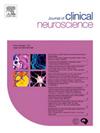Novel association of the Rotterdam computed tomography score with decompressive craniectomy in acute traumatic subdural hematoma
IF 1.8
4区 医学
Q3 CLINICAL NEUROLOGY
引用次数: 0
Abstract
Background and Objectives
The decision to perform a craniotomy (CO) versus decompressive craniectomy (DC) for acute subdural hematomas (aSDH) after traumatic brain injury (TBI) remains challenging. Rotterdam Computed Tomography (RCT) scoring has been shown to correlate with outcome measures in TBI. This study examines the association between RCT scoring and the decision to pursue CO or DC in TBI patients with aSDH.
Methods
A single-center retrospective review was conducted on adult patients who presented with aSDH and received either a CO or DC between 2018 and 2021. Baseline demographics and clinical presentation characteristics were collected. Chi-square, Wilcoxon sum rank test, and t-test were used to compare means. Multivariate stepwise logistic regression models were developed for a predictive model and the receiver operating characteristic curve was analyzed.
Results
A total of 126 patients were identified. Patients who underwent DC compared to CO had significantly younger age, higher Injury Severity Scores (ISS), lower Glasgow Come Scale (GCS), and higher RCT scores. After multivariate stepwise logistic regression, GCS and RCT scores greater than or equal to 3 (RCT3) were independently associated with DC in aSDH. Patients with RCT3 were three times more likely to undergo DC (odds ratio 3.22; 95% confidence interval: 1.19–8.67).
Conclusion
A RCT score of greater than or equal to 3, a younger age, and lower GCS were associated with increased odds of undergoing DC compared to CO for traumatic aSDHs. RCT scores are associated with DC versus CO in patients with aSDH.
鹿特丹计算机断层扫描评分与急性外伤性硬膜下血肿减压颅骨切除术的新联系
背景与目的外伤性脑损伤(TBI)后急性硬膜下血肿(aSDH)的选择是开颅手术(CO)还是减压颅腔切除术(DC)仍然具有挑战性。鹿特丹计算机断层扫描(RCT)评分已被证明与TBI的预后指标相关。本研究探讨了RCT评分与脑外伤合并aSDH患者选择CO或DC之间的关系。方法对2018年至2021年期间出现aSDH并接受CO或DC治疗的成年患者进行单中心回顾性研究。收集基线人口统计学和临床表现特征。均值比较采用卡方检验、Wilcoxon和秩检验和t检验。建立多元逐步logistic回归模型作为预测模型,分析受试者工作特征曲线。结果共发现126例患者。与CO相比,接受DC的患者明显更年轻,损伤严重评分(ISS)更高,格拉斯哥评分(GCS)更低,RCT评分更高。经多变量逐步logistic回归,GCS和RCT评分大于或等于3分(RCT3)与aSDH的DC独立相关。RCT3患者发生DC的可能性是前者的3倍(优势比3.22;95%置信区间:1.19-8.67)。结论创伤性aSDHs的RCT评分大于或等于3分、年龄较小、GCS较低与DC的发生率比CO高相关。在aSDH患者中,RCT评分与DC和CO相关。
本文章由计算机程序翻译,如有差异,请以英文原文为准。
求助全文
约1分钟内获得全文
求助全文
来源期刊

Journal of Clinical Neuroscience
医学-临床神经学
CiteScore
4.50
自引率
0.00%
发文量
402
审稿时长
40 days
期刊介绍:
This International journal, Journal of Clinical Neuroscience, publishes articles on clinical neurosurgery and neurology and the related neurosciences such as neuro-pathology, neuro-radiology, neuro-ophthalmology and neuro-physiology.
The journal has a broad International perspective, and emphasises the advances occurring in Asia, the Pacific Rim region, Europe and North America. The Journal acts as a focus for publication of major clinical and laboratory research, as well as publishing solicited manuscripts on specific subjects from experts, case reports and other information of interest to clinicians working in the clinical neurosciences.
 求助内容:
求助内容: 应助结果提醒方式:
应助结果提醒方式:


